1128 According to legend King David 1st was attacked by a stag whilst hunting in grounds now known as Holyrood Park. He saw a cross (or rood) between the antlers, and believed this to represent a relic of the true cross which was said to be in the possession of his mother, Queen Margaret.
That night, in a dream, a voice told him to build an Augustinian monastery on the spot where the stag had appeared.
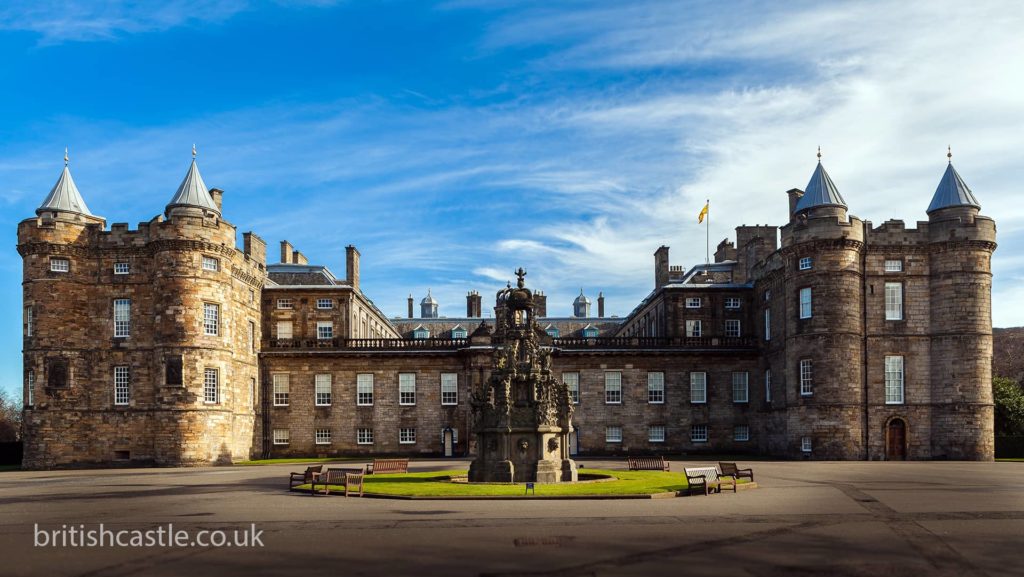
Although now in ruins, parts of the original abbey founded by David can still be seen today.
The Abbey flourished. Over the centuries many of Scotland’s monarchs chose to stay in the guest house of the Abbey when the court was in Edinburgh, in the pleasant surroundings of the park lands, rather than in the Castle, with its forbidding military aspect.
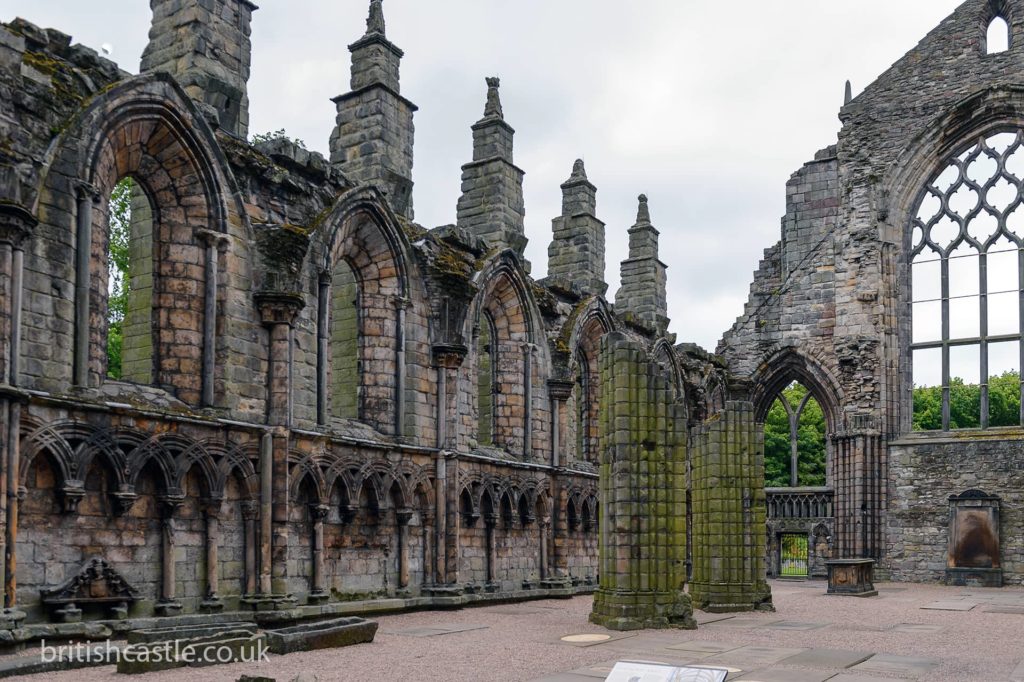
It is believed that James 2nd was born at Holyrood in 1430 and was crowned, and married, in the Abbey. Although he died at Roxburgh Castle, he was buried at Holyrood.
1501 James 4th built a Royal Palace on the site of the old guest house, close to the abbey cloister, and it is from this date that Holyrood Palace became an official residence of Scottish kings and queen’s and – from the Union of Crowns in 1603 – of the English monarchy. (The title King of Scotland ceased to exist following the Union of Parliaments in 1707.)
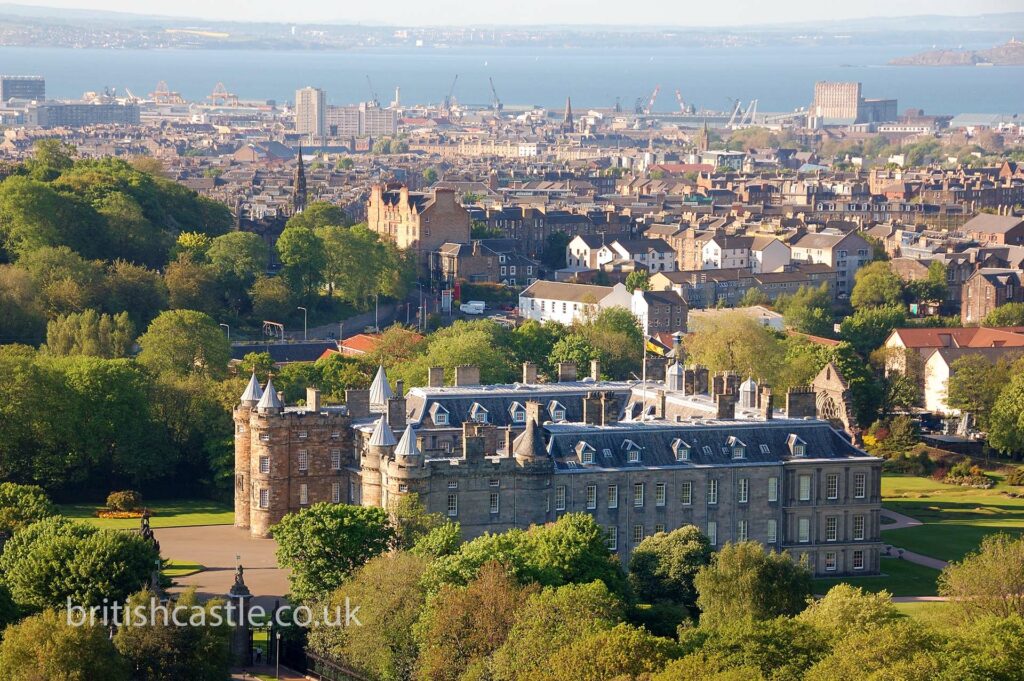
The new palace contained chapel, separate apartments for the King and Queen, a gallery and a great hall. These accommodations were designed to provide comfort and luxury for the royal family. A gate-house was also constructed – fragments of which can still be seen in the Abbey Courthouse.
1528 – 1536 James 5th extended the Palace with a north-west tower and a new west front at the time of his first marriage to Madeleine, daughter of Francis 1st of France. His second wife, Mary of Guise , was crowned in the Abbey.
In the north-west tower are the rooms now known as the apartments of their daughter Mary, Queen of Scots.
1561 Mary returned to Scotland following the death of her first husband, Francis 2nd of France, and took up residence in Holyrood Palace. Little of the palace furnishings from that time remain; the magnificent bed of crimson damask, for many years believed to be that of Queen Mary, is now known to have been purchased by the 3rd Duke of Hamilton in the 17th century.
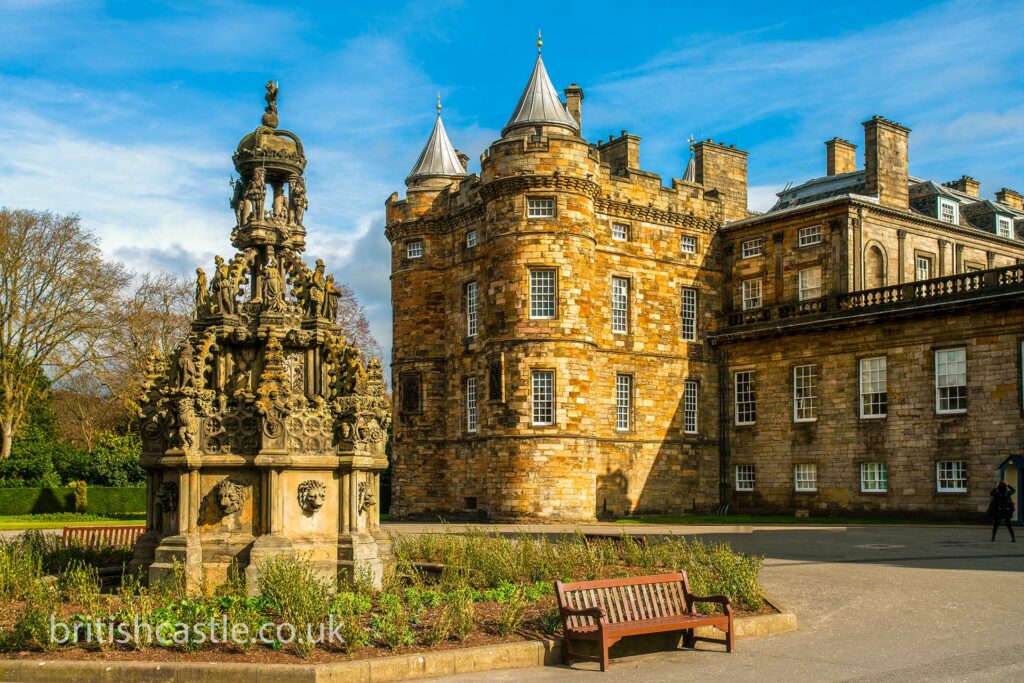
Many of the family portraits, however, are now in the Hamilton collection at Lennoxlove in East Lothian.
1565 Mary married her first cousin Henry Stuart, Lord Darnley in the Abbey.
1566 Darnley came to believe that Mary was having an affair with her private secretary, David Rizzio. In March of this year Darnley, and a group of conspirators, murdered Rizzio – in the presence of Mary – in the turret room of the north-west tower.
1566 In July the son of Mary and Darnley (later to become James 6th of, Scotland and James 1st of England) was born in Edinburgh Castle.
1567 In February Darnley was murdered. Although never proven, it was widely believed that his death was at the hands of James Hepburn, 4th Earl of Bothwell.
In May of this year Mary and Bothwell were married at Holyrood Palace according to the rites of the Protestant Church, even though Mary was a devout Catholic. Later this year Mary was imprisoned, and remained a captive for the rest of her life. She was never to return to Holyrood.
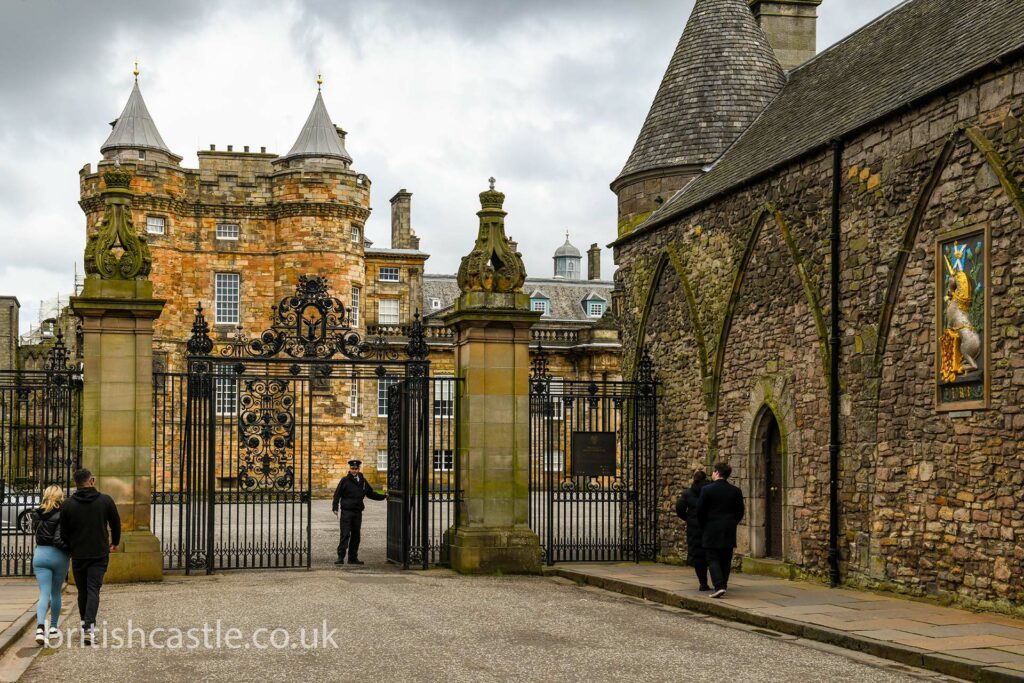
1603 After her son James 6th of Scotland became James 1st of England in 1603 he moved to London. Although he visited Holyrood in 1617, the palace was no longer the home of the royal court.
1633 The Scottish coronation of James’ son, Charles 1st, was held in Holyrood Abbey and, following a period of some decline the Palace was restored to some of its former glory to mark the occasion.
1646 Charles 1st conferred the Office of Keeper of Holyrood house on the 1st Duke of Hamilton and his heirs. The family retain apartments in the Palace to this day.
The Dukes of Hamilton appoint the Bailie of Holyrood house, who has responsibility for law and order within the sanctuary of the Abbey.
1650 During the Civil War, whilst Oliver Cromwell’s troops were billeted at Holyrood, the palace suffered severe fire damage.
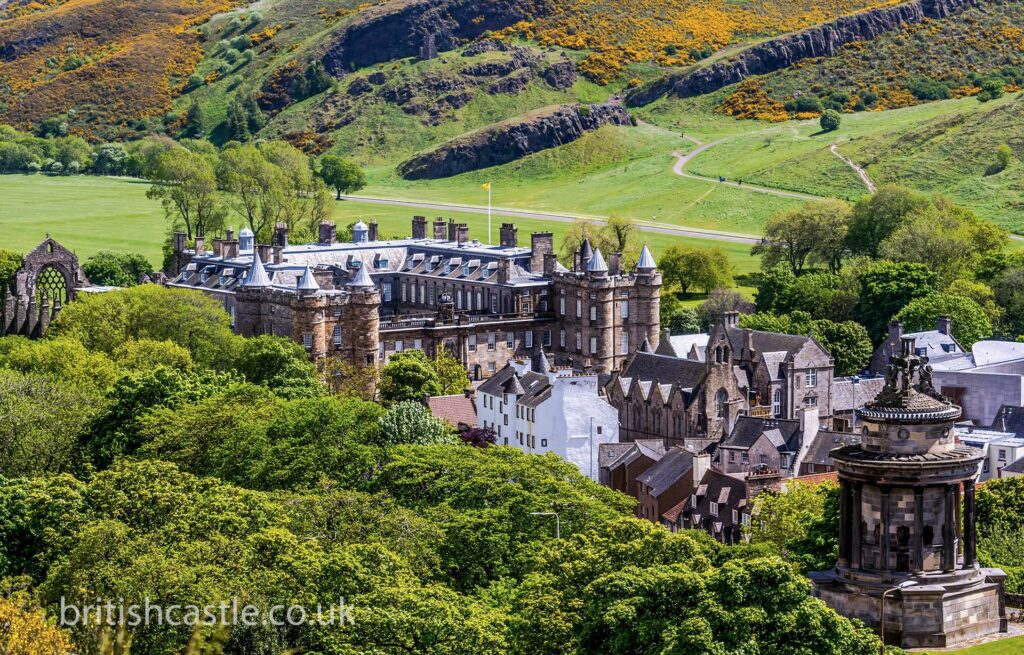
1661 After the restoration of the monarchy Charles 2nd was crowned in Scotland. Although he did not return, he ordered the extensive reconstruction of the Palace between 1671 and 1679, which became the royal residence for his brother James, Duke of York. The Duke subsequently became James 2nd of Scotland and 7th of England in 1685, but after a short and troubled reign he was deposed, and succeeded by his Protestant daughter Mary and her husband William in 1689.
1707 Following the Act of Union the Palace was used for the elections of Scottish peers to the British parliament.
1745 During the Jacobite Rising Charles (Bonnie Prince Charlie) held court in the Palace until the rebellion was suppressed by the Duke of Cumberland.
1768 The roof of the Abbey Church collapsed. No restoration has been carried out and the church, together with much of the Abbey itself, remains in ruins.
1822 Extensive renovations were carried out in the Palace in preparation for the State Visit of George 4th, who ordered that the apartments of Mary queen of Scots should be maintained and preserved in their existing state. He also decreed that during the annual General Assembly of the Church of Scotland in May, the Lord High Commissioner should have full use of the Palace.
1830 After the Revolution in France, George 3rd had allowed the Compte d’Artois, youngest brother of Louis 16th, to enjoy the sanctuary of the Abbey. After their second exile from France the Compte and his family again resided in the Palace until their eventual exile to Austria in 1832.
1842 Queen Victoria made her first visit to the Palace, re-establishing the custom of using it as an official royal residence when in Scotland.
1871 A private suite was created for Queen Victoria on the second-floor of the palace in rooms formerly occupied by the Dukes of Argyll.
1922 The forecourt was enlarged to a grand design as a memorial to Edward 7th. George 5th and Queen Mary were responsible for considerable restoration and renovation of the Palace installing electricity, modern plumbing and lifts. They also established the tradition of the Royal Garden Party which is still held in the grounds of the Palace during the Queen’s annual State Visit to Scotland in June/July of each year.
Present day The Palace of Holyrood House is the prime State Residence of the Royal Family when in Scotland.
When not in use by the King or his family, or for State functions, the Palace and grounds are open to the public.
History and Architecture
Holyrood Palace, the official residence of the British monarch in Scotland, boasts a rich history that stretches back to the 12th century. Originally built on the site of a 12th-century Augustinian abbey founded by King David I of Scotland, the palace has seen numerous transformations over the centuries. Each monarch left their mark, contributing to the palace’s unique blend of architectural styles. Today, Holyrood Palace is a stunning amalgamation of medieval, Renaissance, and Baroque elements. The State Apartments, in particular, stand as a testament to 17th-century Scottish architecture, showcasing the grandeur and elegance that has defined the palace through the ages.
State Apartments
The State Apartments at Holyrood Palace are a highlight for any visitor, offering a glimpse into the opulent world of royal life. These grand rooms have hosted countless official events and receptions over the centuries and continue to serve as the setting for state occasions today. Among the most notable rooms are the Throne Room, the Picture Gallery, and the Dining Room. The Dining Room, with its stunning ceiling and intricate woodwork, is a particular marvel. Each room in the State Apartments tells a story of the palace’s rich history and its enduring role as a royal residence, making them an essential part of any visit to Holyrood Palace.
Palace Gardens
The Palace Gardens at Holyrood Palace provide a tranquil escape from the hustle and bustle of Edinburgh. Restored to their original 17th-century design, the gardens feature a delightful array of plants and flowers, a stunning fountain, and a picturesque pond. Visitors can enjoy a leisurely stroll through these beautifully maintained grounds, soaking in the peaceful atmosphere and taking in the breathtaking views of the palace. The gardens are a perfect complement to the grandeur of the palace itself, offering a serene and picturesque setting that enhances the overall visitor experience.
Visiting the Palace
A visit to Holyrood Palace offers a rich and immersive experience, with plenty to see and do. Guests can explore the magnificent State Apartments, wander through the serene Palace Gardens, and delve into the history of the Abbey, which houses a fascinating collection of artefacts and exhibits. The palace also offers a variety of guided tours, including detailed tours of the State Apartments and the Palace Gardens. Throughout the year, visitors can enjoy a range of events and exhibitions, from concerts and re-enactments to art displays. Whether you’re interested in history, architecture, or simply enjoying a beautiful setting, Holyrood Palace has something to offer.
Conservation and Restoration
As a Grade A listed building, Holyrood Palace is subject to rigorous conservation and restoration efforts to preserve its historical integrity. Managed by Historic Environment Scotland, the palace undergoes continuous maintenance to ensure its long-term sustainability. Over the years, numerous restoration projects have been undertaken, including a significant restoration of the State Apartments in the 1990s. These efforts ensure that Holyrood Palace remains a vibrant royal residence and a cherished tourist destination. The ongoing conservation work allows visitors to appreciate the palace’s historical and architectural significance for generations to come.
Read more about Castles in Scotland.